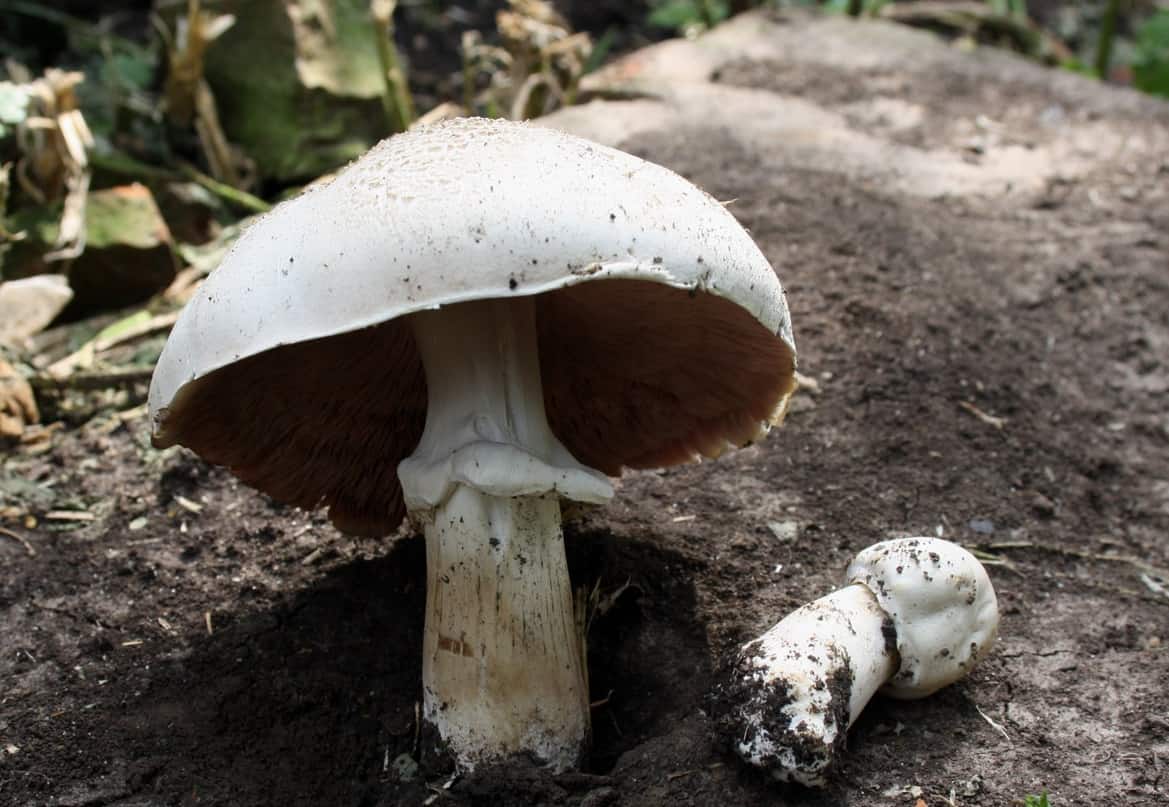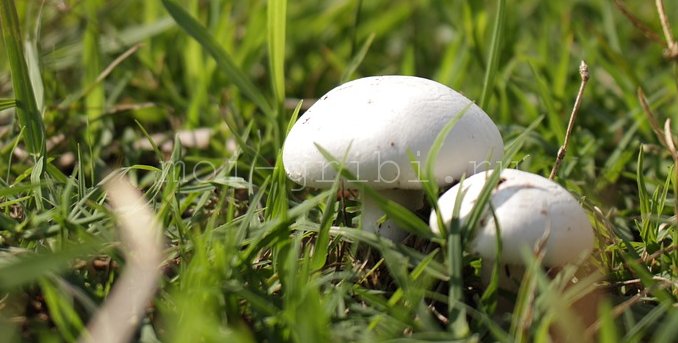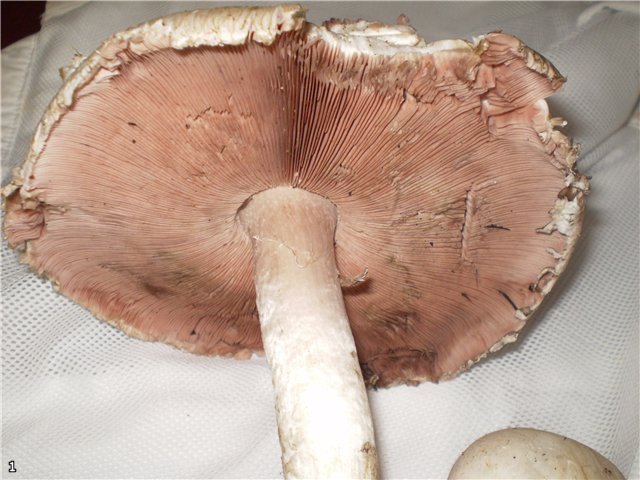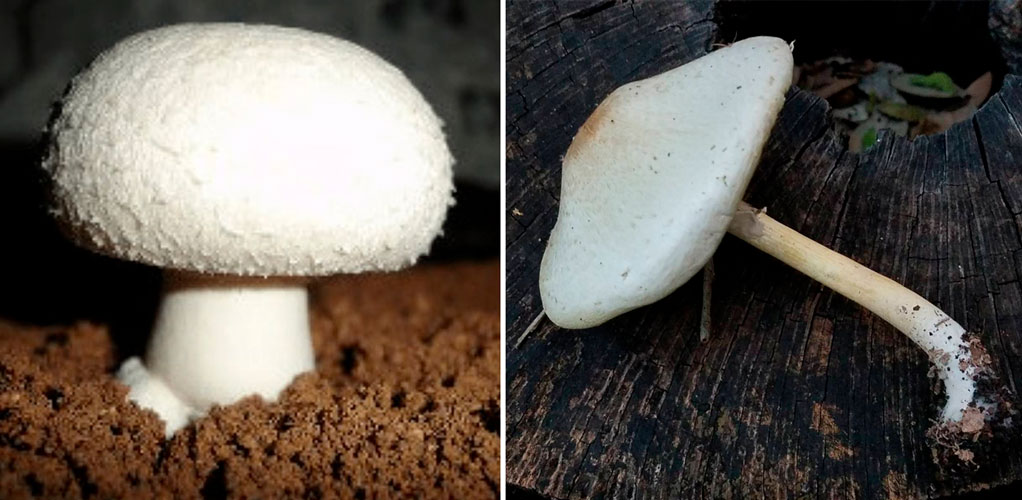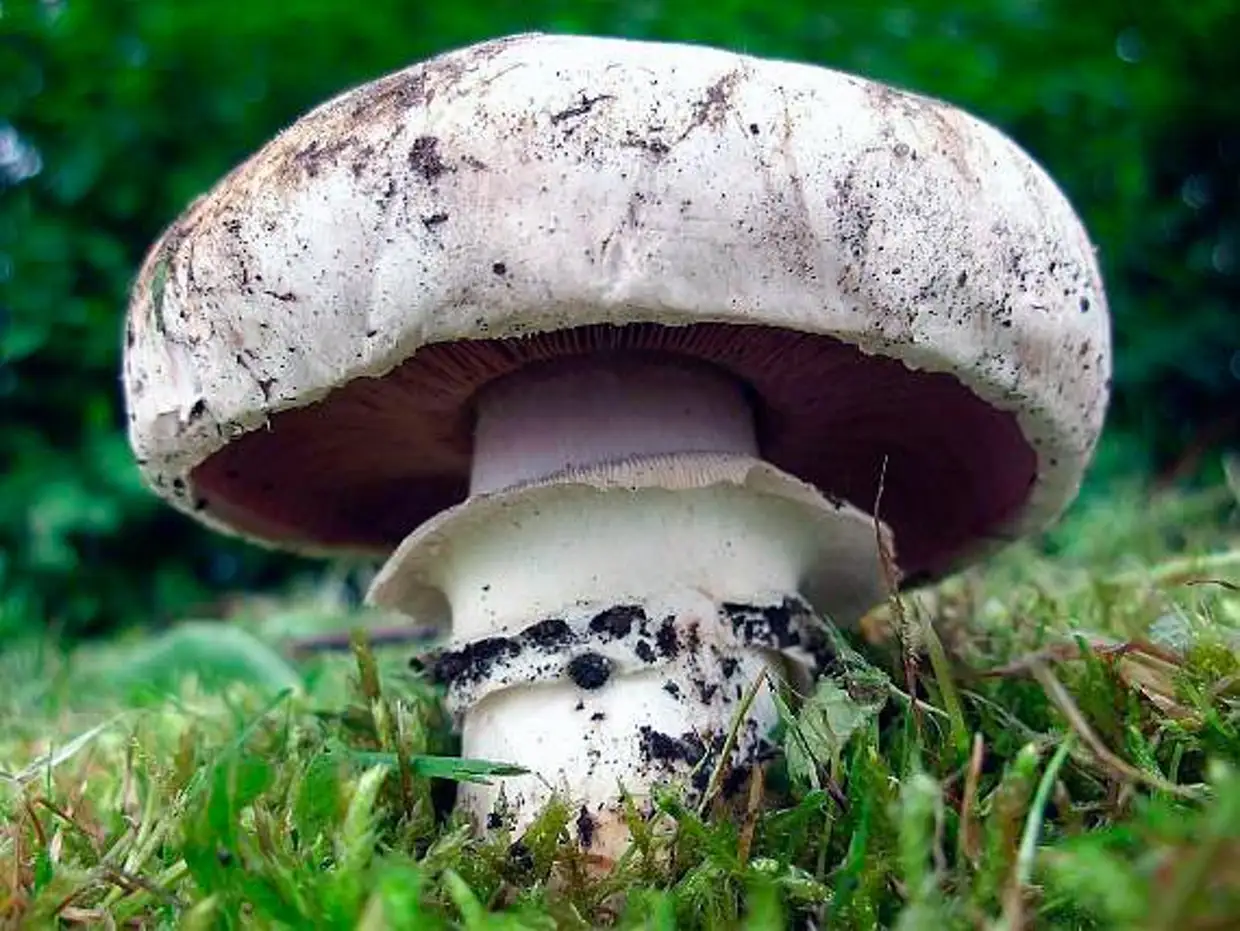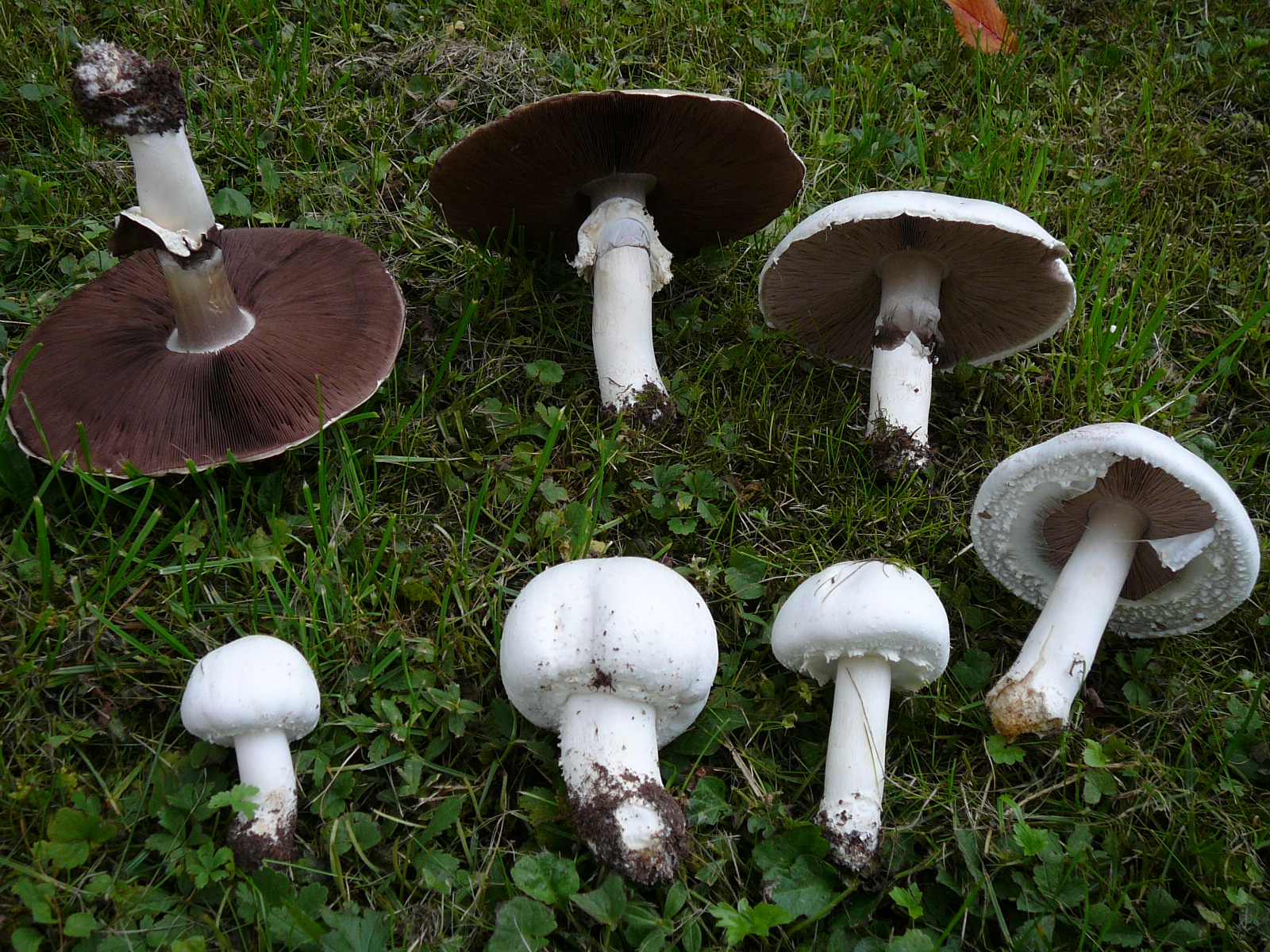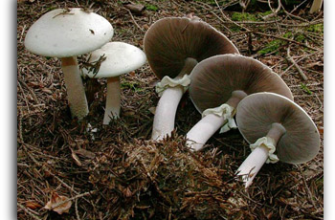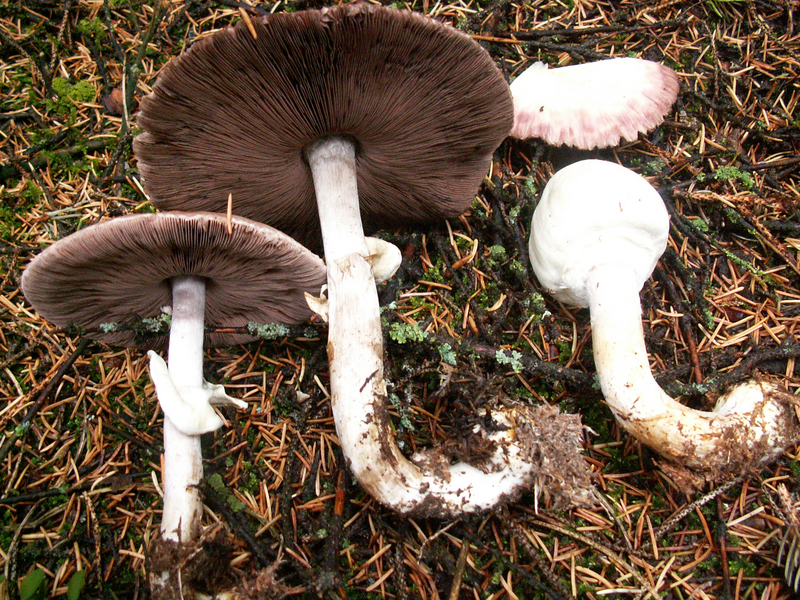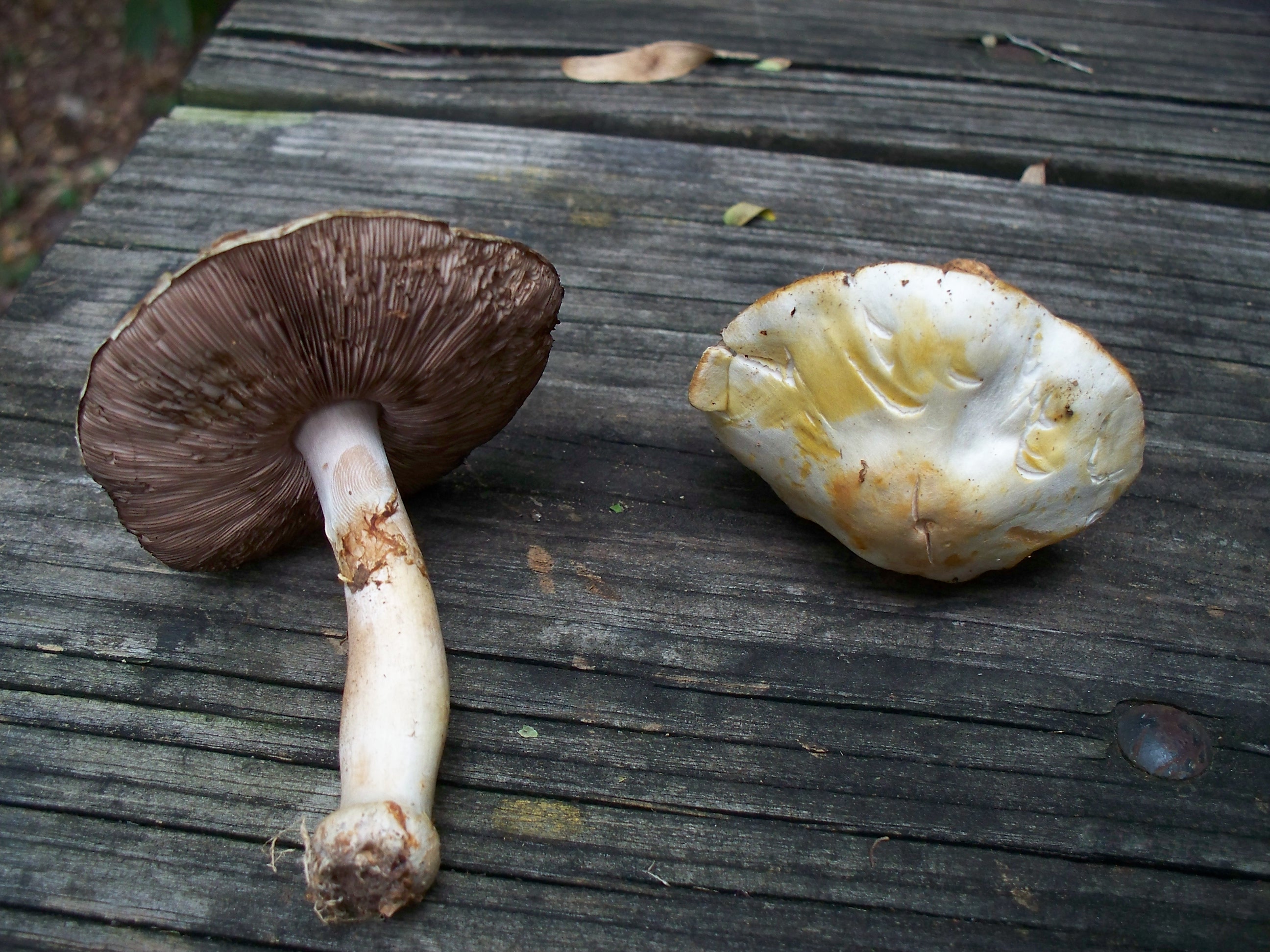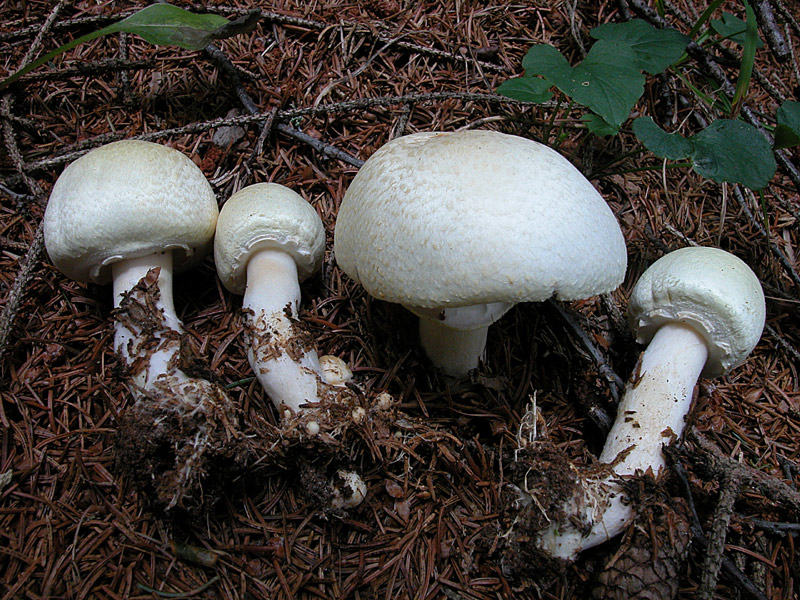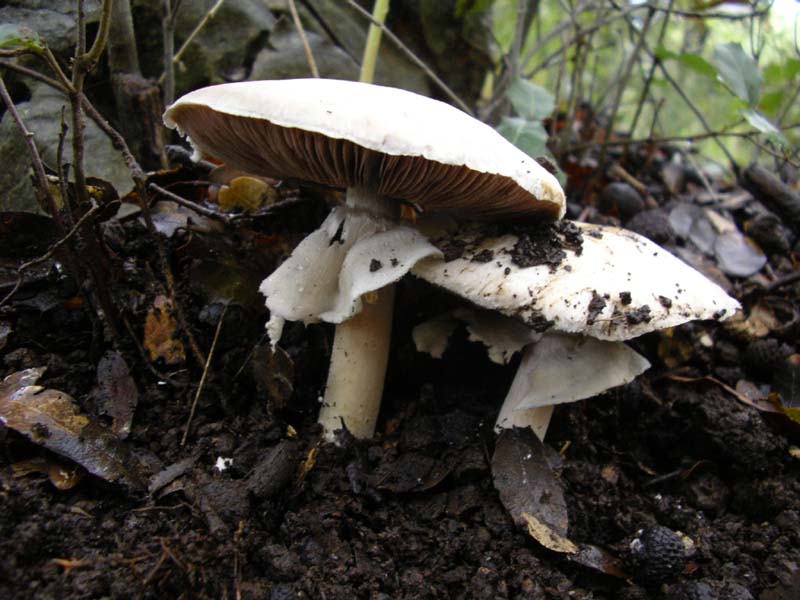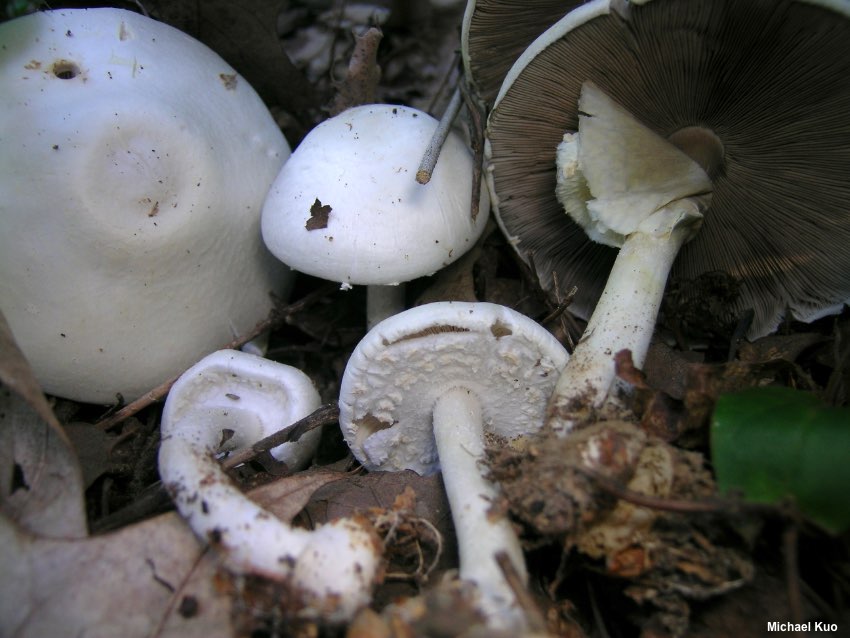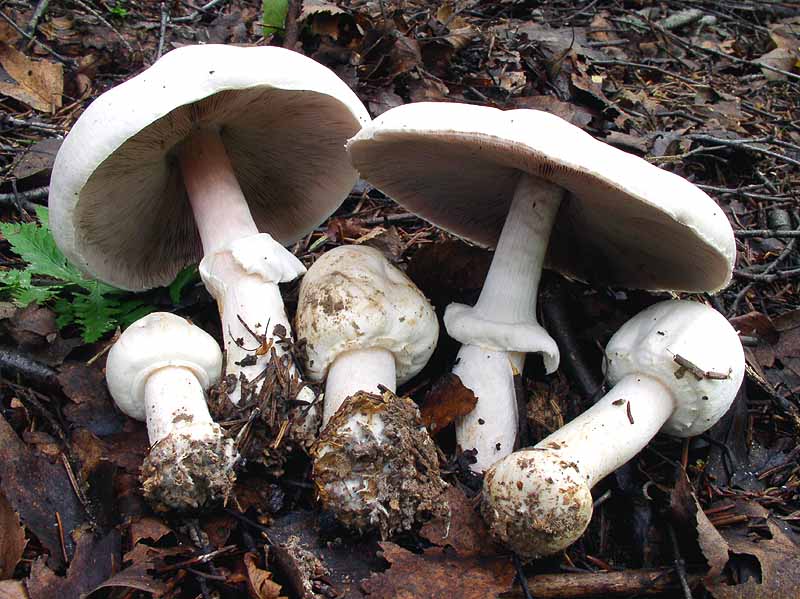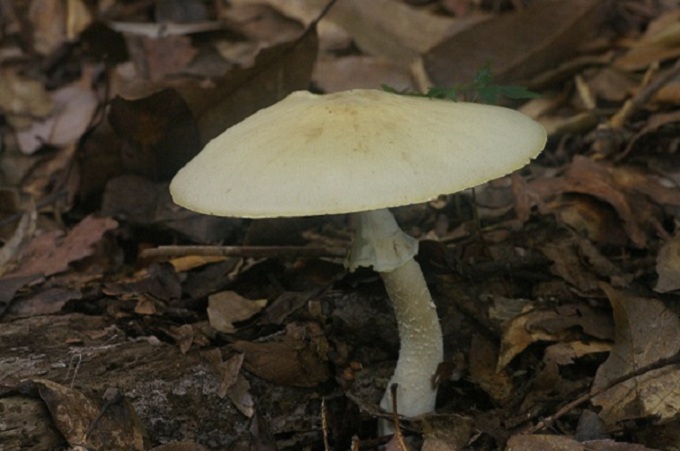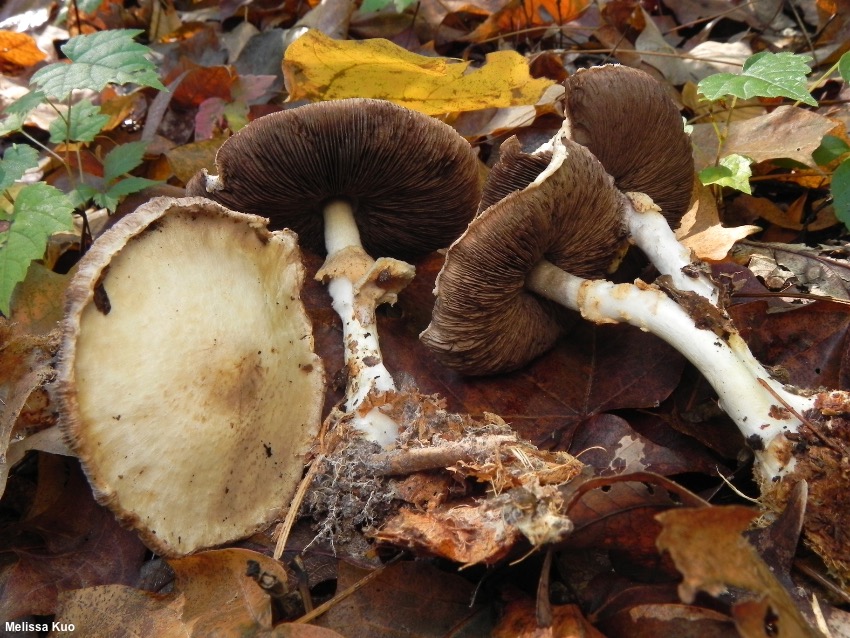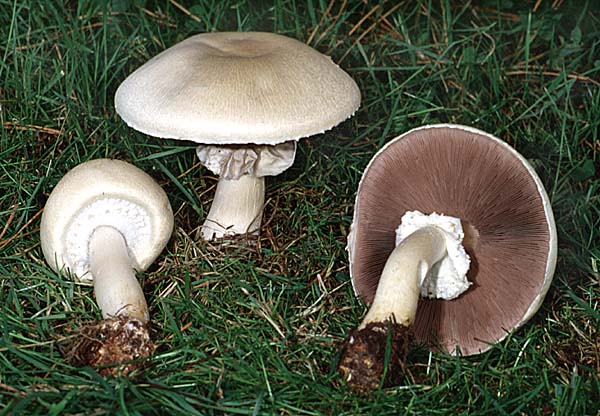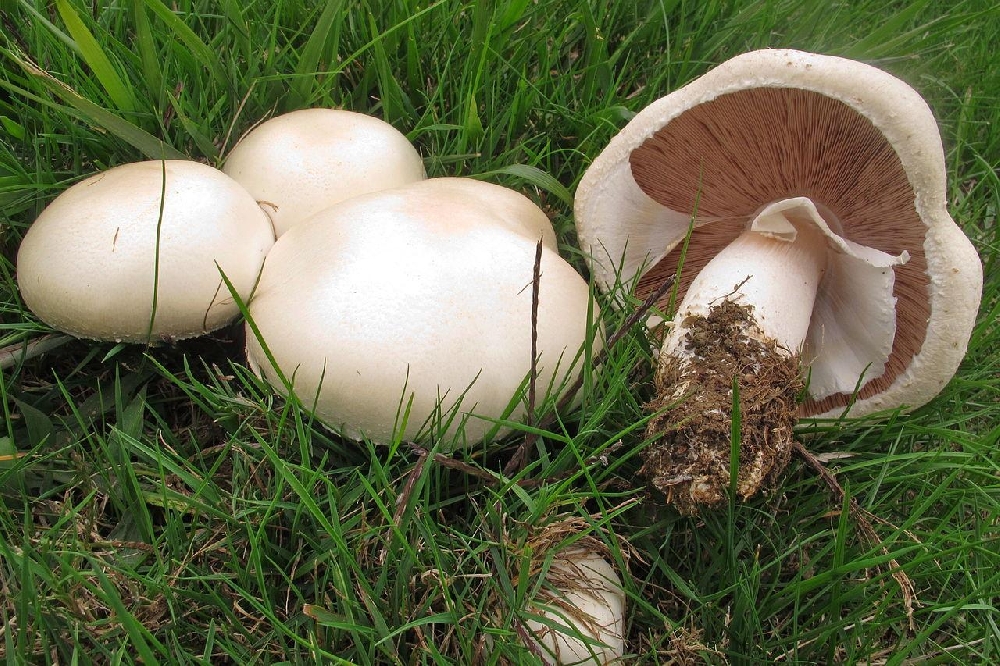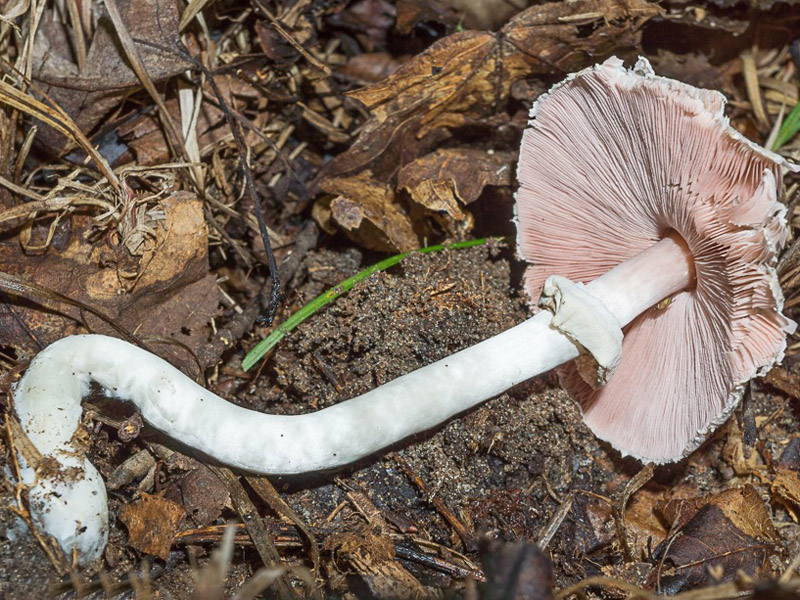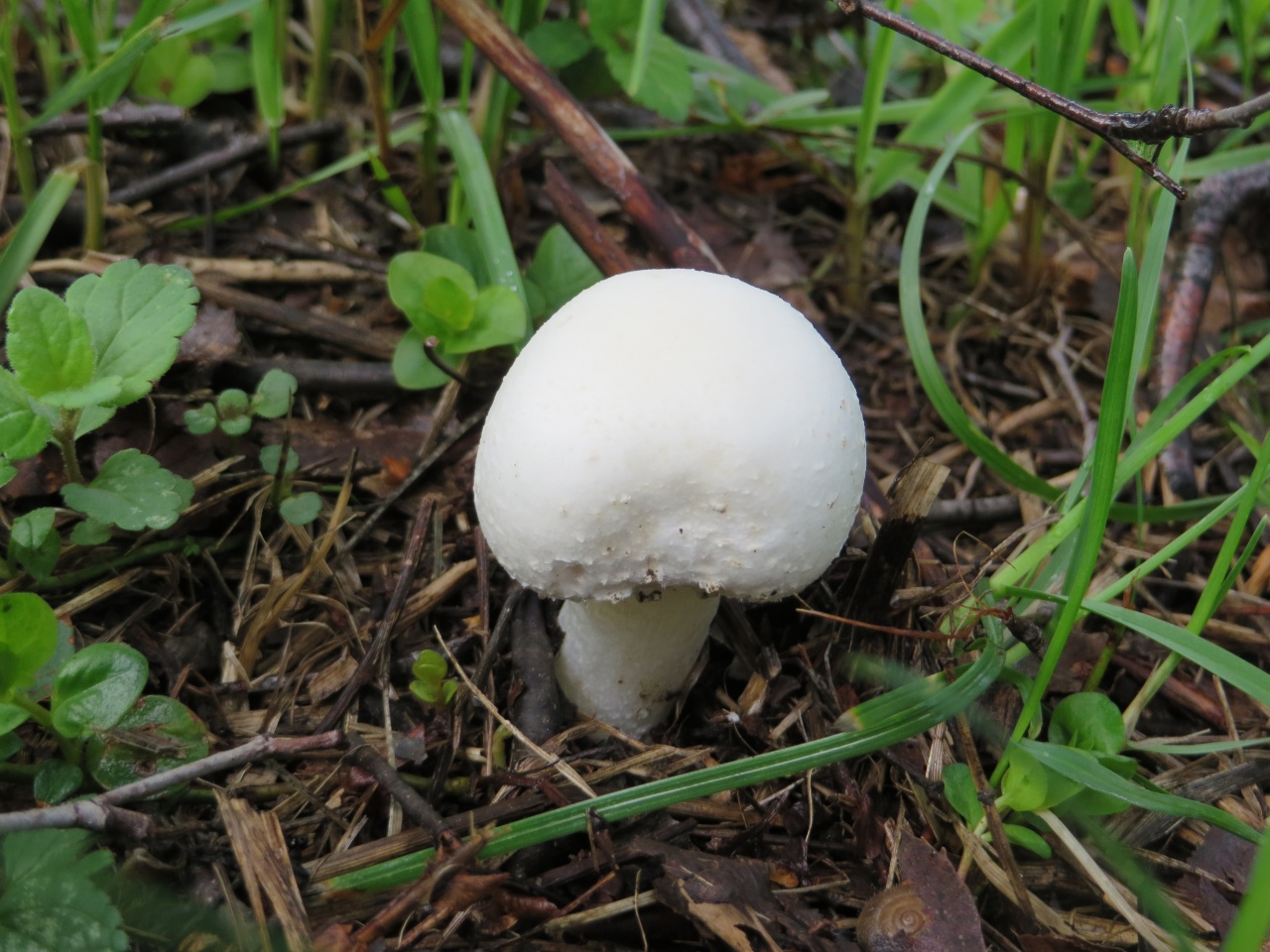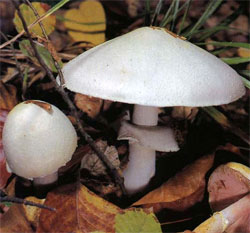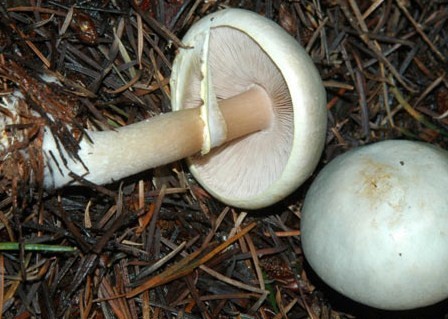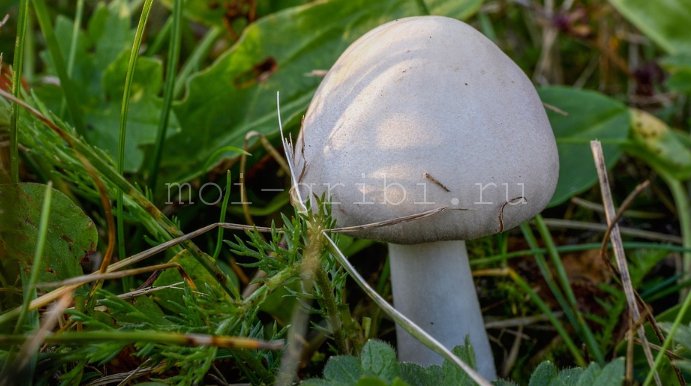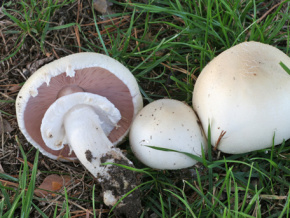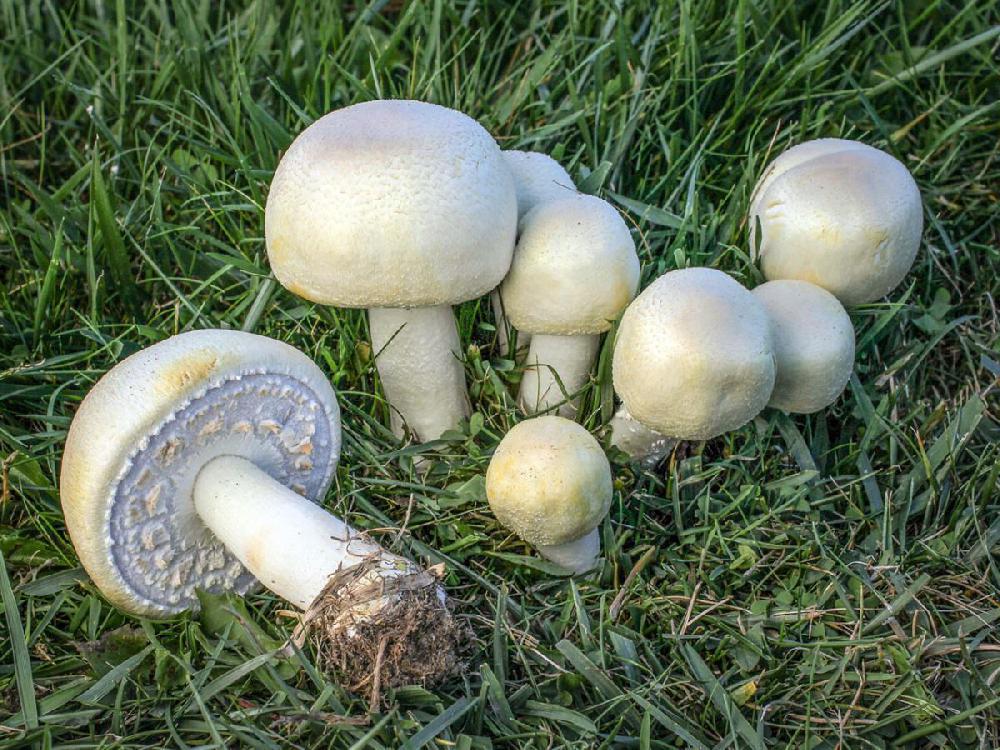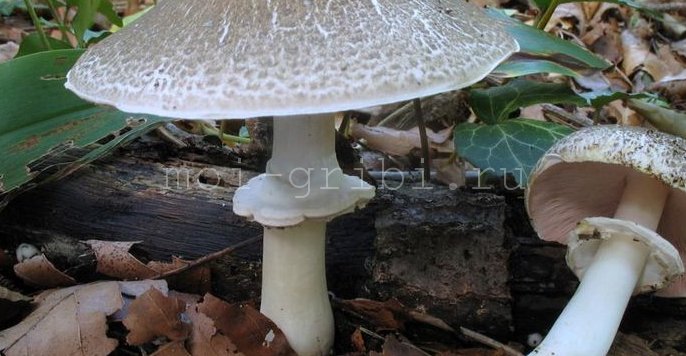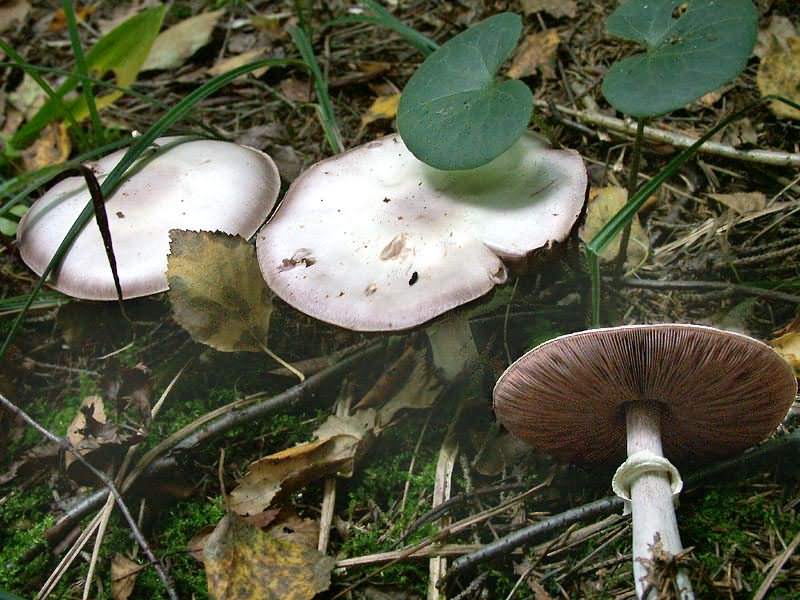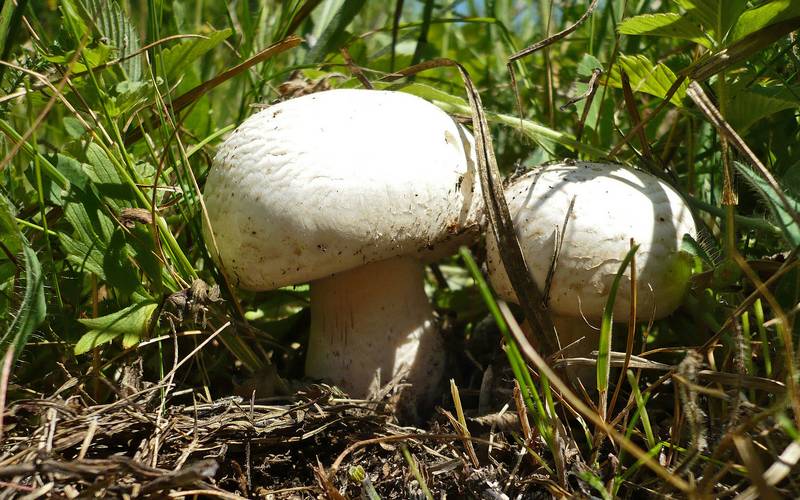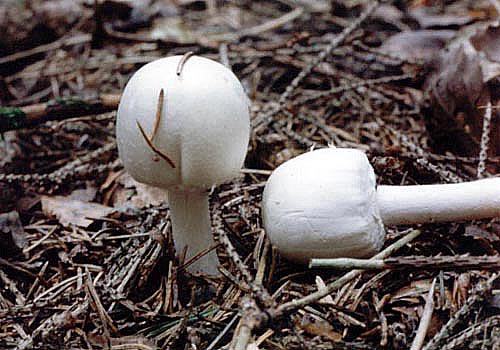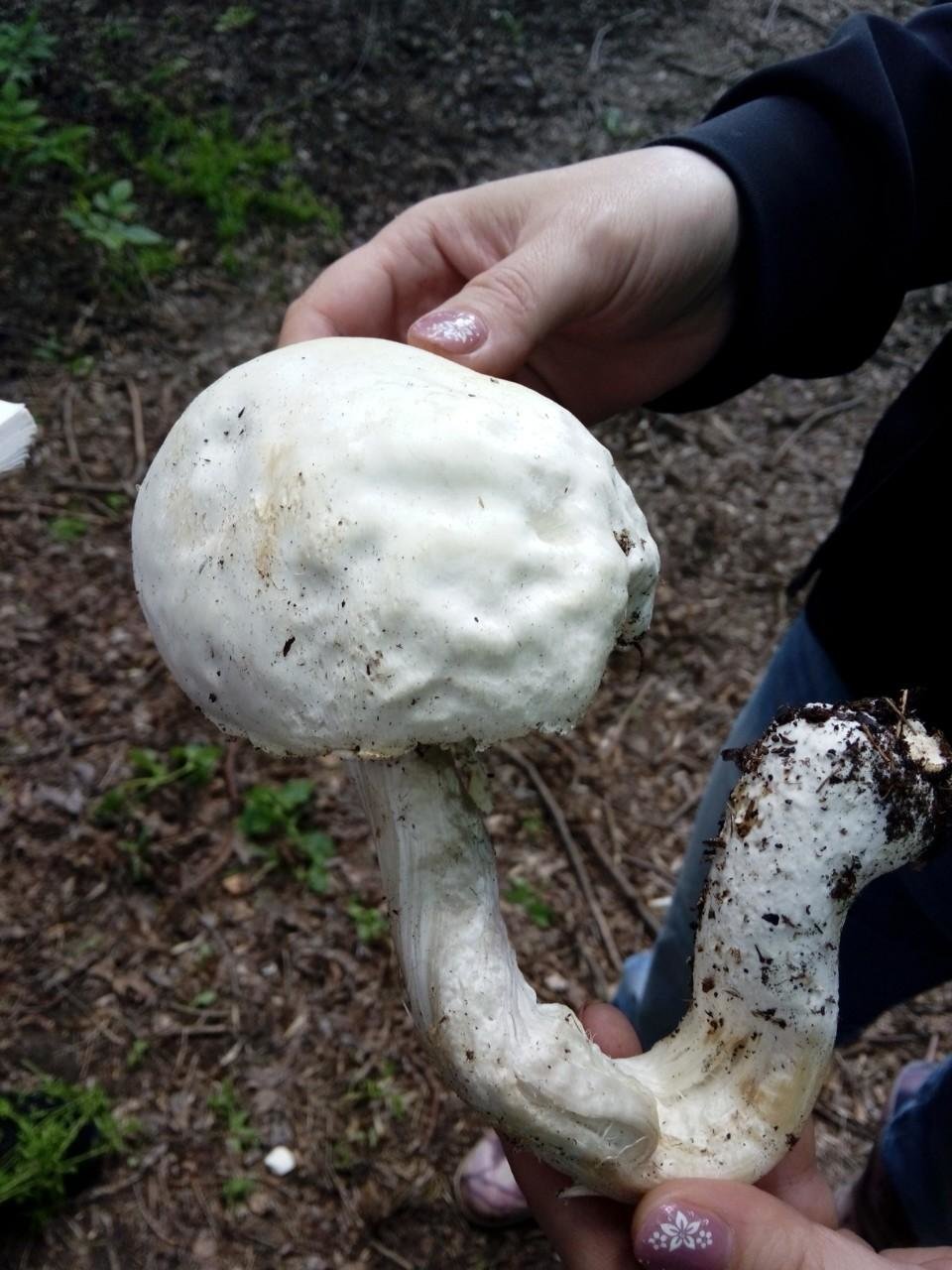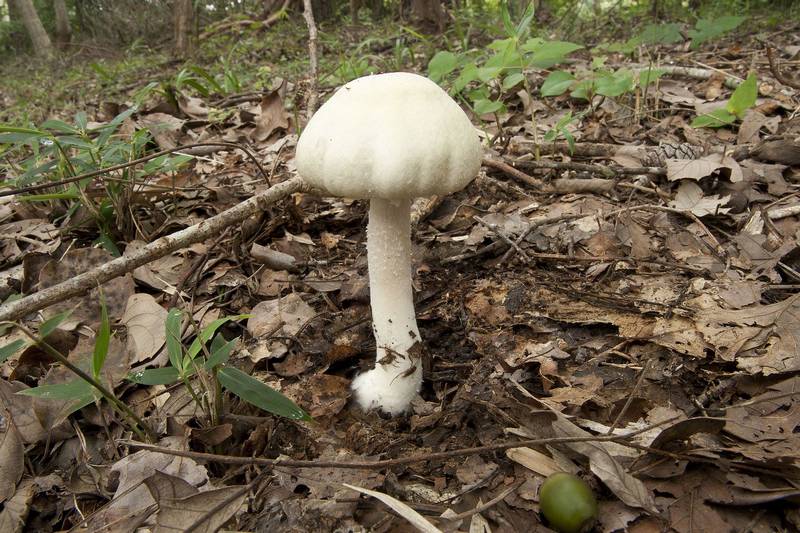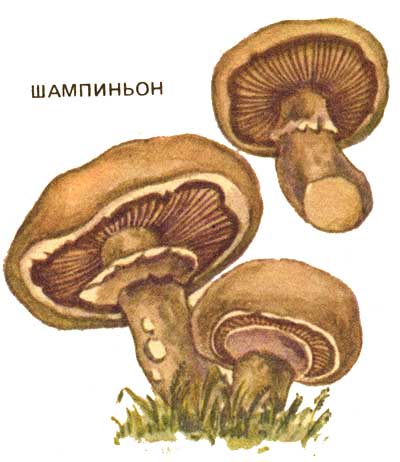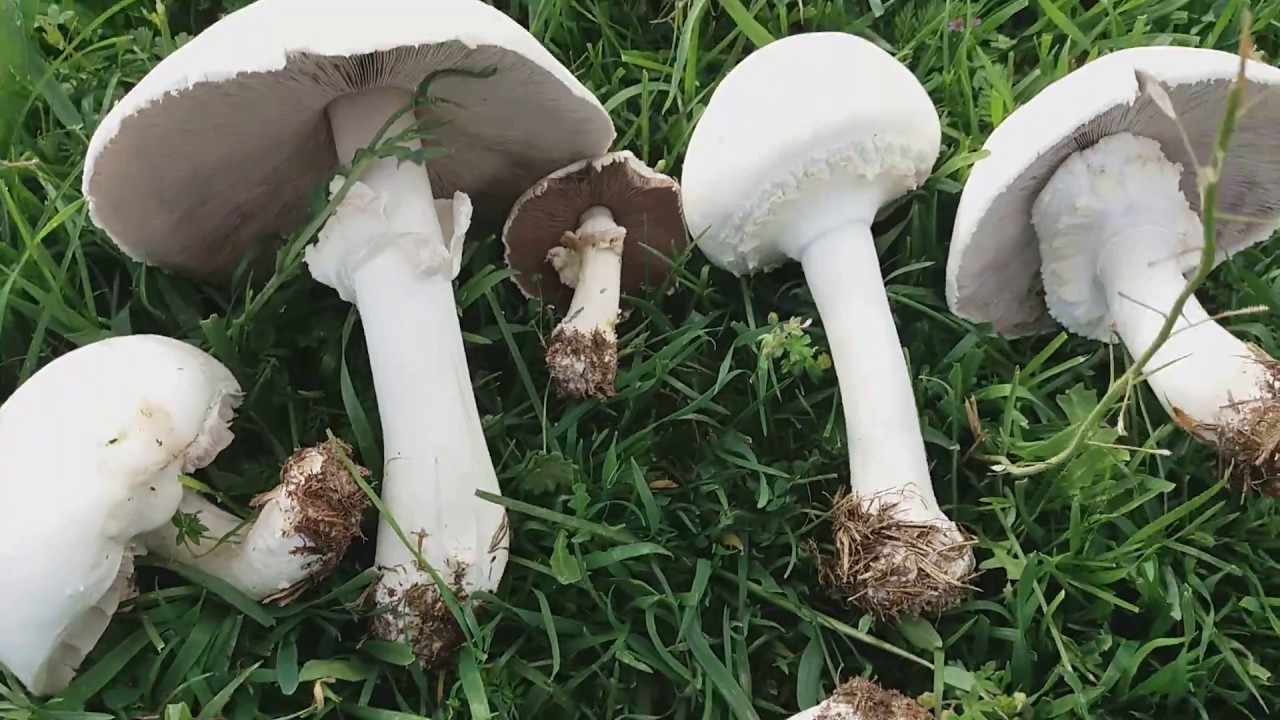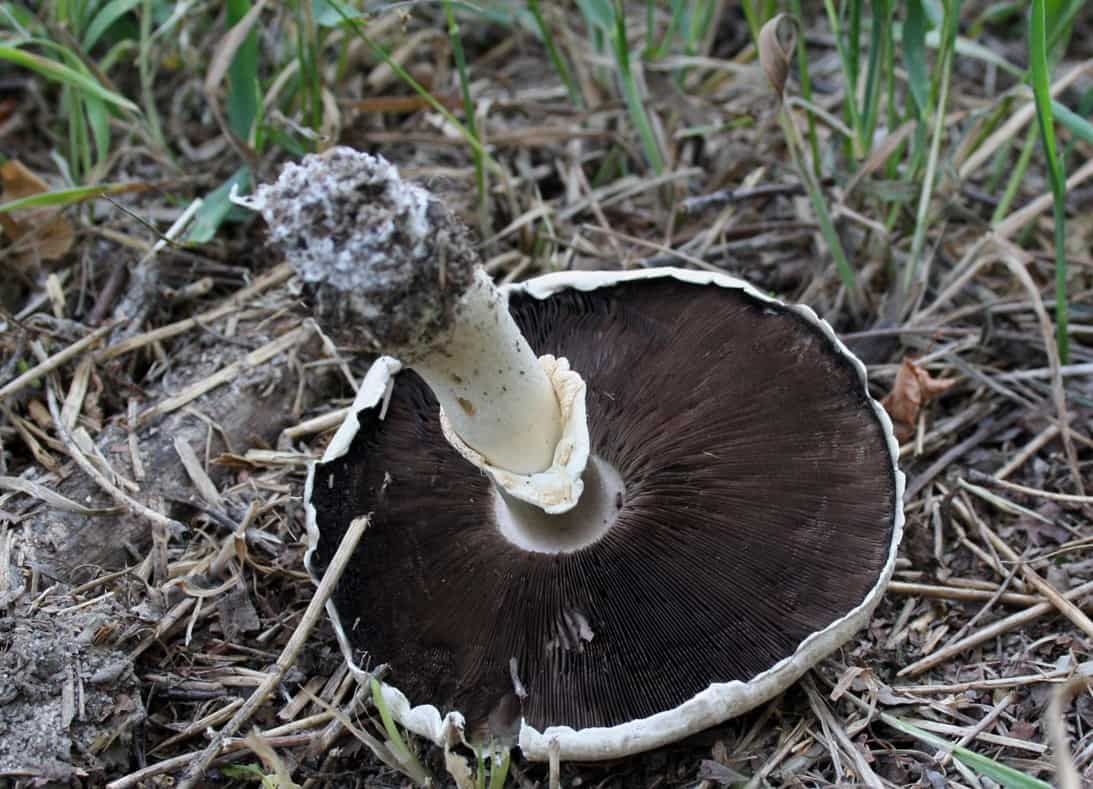Forest mushroom
Forest mushroom (lat.Agaricus silvaticus)
Forest mushroom (lat. Agaricus silvaticus)
Popularly referred to as a wolf mushroom. Also known as blagushka and cap.
It is less popular with mushroom pickers because of its reddening pulp. It can be eaten in all forms, even raw. It got its name because of its "residence". It has a pleasant smell and excellent taste. It grows mainly in spruce and coniferous forests. Less common in mixed forests. It prefers to grow near anthills and, in frequent cases, at their very top.
The leg is straight or curved. In young mushrooms, it is whole, becoming hollow over time. The thickening in the lower part of the leg becomes thin closer to the cap. Height 5-10 cm. The color of the leg is dirty gray. It has a thin ring at the top. During the ripening process, the ring disappears.
The cap of the young forest mushroom is ovate-bell-shaped, the color varies from light gray to brown-brown in maturity. At this age, the cap takes on a prostrate shape. The size of the cap is 5-10 cm, often up to 15. The cap is covered with large brown scales. The pulp, unlike most champignon mushrooms, is rather thin and light. When cut, it turns red.
Forest mushroom photo
Forest mushroom (lat.Agaricus silvaticus) Forest mushroom (lat.Agaricus silvaticus) Forest mushroom (lat.Agaricus silvaticus)
Champignon august
Champignon august (lat.Agaricus augustus)
Champignon august (lat. Agaricus augustus)
Of all types of champignons, this is the largest mushroom. It got its name from the timing of its appearance and maturation. You can find it from mid-August to the end of September, mid-October. His favorite habitats are coniferous and deciduous forests. It is not uncommon to be found near anthills or directly on them. Grows in groups. But this is not a common mushroom. It is not so common.
An easily recognizable mushroom. The cap is light yellow with brown scales. Unlike its counterpart in the forest mushroom family, which it looks like, the August mushroom has a brownish brown rather than golden cap base.
The hat is quite large, up to 15cm in diameter. It can reach 20 cm. It is dark orange or dark brown in color. Thin. Young mushrooms have a closed, hemispherical cap. With age, the cap becomes open. The edges of the cap are bordered by a large, hanging blanket. A distinctive feature of this mushroom is the brown scales that cover the cap.
The plates are bristling, free. With age, they change color from pale pink in youth to brownish-black in old age.
The leg is long and strong. Hollow inside. Covered with flaky yellow-brown scales. On the leg, a large hanging, folded ring is clearly visible, under which scales are also located. The color is whitish yellow.
The flesh of the August champignon has a pleasant, almond smell, fleshy. On the cut, the color changes from yellow to brown.
Like all mushrooms of this species, it is rich in phosphorus and potassium, vitamins A, B, C, PP, which have a detrimental effect on typhoid pathogens.
Champignon august belongs to the third category of mushrooms in terms of its nutritional value. Very tasty. It is usually consumed fresh, but it is also suitable for pickling and drying.
But you should not abuse it because of the ability to accumulate in the body such a harmful substance as cadmium.
Champignon august photo
Champignon August (Latin Agaricus augustus) Champignon August (Latin Agaricus augustus) Champignon August (Latin Agaricus augustus)
Champignons - type, description of mushrooms, where they grow in nature
Main types and characteristics
Champignons are the most popular mushrooms in our time.They are very tasty, healthy and even medicinal, as they contain proteins, carbohydrates and mineral salts. In terms of nutritional value and nutritional value, mushrooms are equated to meat.
These mushrooms can be easily recognized by their appearance. Usually white and less often brown fleshy caps. The pulp is white, but when interacting with oxygen it changes color to red or yellow. The plates in young specimens are pinkish. Over time, they acquire a brown color. The leg is dense, white, up to 10 cm high.
Here are the most popular of them, which won the love of mushroom pickers and ordinary people:
- Garden (double-sided). It grows on cultivated and fertilized soils - in a greenhouse, in a vegetable garden and pasture. In the wild, it is found in temperate countries of Europe, where the soil is completely free of grass cover. Juicy light flesh, which turns pink when broken. White leg, almost hollow, cylindrical in shape.
- Steppe (Bernard). The main place of its growth is desert or semi-desert. This type of champignon loves saline soils. Grows in groups. Can be confused with common champignon. The color of the cap is varied: from white to brown. Plates are located below the cap. The leg is of the same color as the head.
- Two-ring. The people also have the name sidewalk or city mushroom. This is an unpretentious and sharply different champignon from other mushrooms in its family. A rather large hat sits on a fleshy low leg. Loves a warm climate. Fruiting from late May until November.
- Dark scaly. Occurs in deciduous or mixed forests from July to September. The hat is convex. The plates are wide and sparsely located. Hollow white leg. The pulp of the mushroom is also white when pressed, first turns yellow, then turns brown.
- Small-scaled (Benesha champignon). It grows in both coniferous and deciduous forests. His flesh is white, but when pressed, it quickly turns red. In cooking, they are often consumed raw. This species can be called stocky, since a fleshy cap sits on a low, but very dense leg. The plates are located close to each other, pinkish hue.
- Steam. Found throughout Europe in mixed forests. It can also grow in meadows and pastures. Does not like direct sunlight. It is usually harvested in the autumn. The hat has a rounded shape that is covered with scales. There are many thin plates under it. The stem itself is of medium length, but goes deep into the soil and has a thickening at the base. The pulp is white and fleshy, with an interesting chicory scent.
- Augustowski. A rare type of champignon found in Europe. They grow in groups from August to October in the park area, near anthills. The cap, like that of other representatives of champignons, changes shape over time, and is covered with orange-brown scales. The pulp has a pleasant almond scent. The mushroom is quite tall.
- Large spore. It grows in Eurasia. Loves meadow soils rich in organic matter. This species is quite large. The cap is smooth and convex, on which large scales appear over time, and the edges become velvety. Such a cap can only be held by a dense high leg, which thickens at the base. A ripe large-spore mushroom has a peculiarity - a smell that flows from a pleasant almond to a pungent smell of ammonia.
Field champignon (Agaricus arvensis)
Other names:
Fruit body: Cap with a diameter of 5 to 15 cm, white, silky-shiny, for a long time hemispherical, closed, then prostrate, drooping in old age. The plates are curved, white-grayish in youth, then pink and, finally, chocolate-brown, free. Spore powder, purplish brown. The leg is thick, strong, white, with a two-layer hanging ring, its lower part is broken in a ray-like manner. It is especially easy to distinguish this mushroom at a time when the coverlet has not yet moved away from the edge of the cap.The pulp is white, yellowing when cut, with an anise smell.
Season and place:
In summer and autumn, field champignon grows on lawns and glades, in gardens, near hedges. In the forest, there are related mushrooms with the smell of anise and yellowing pulp.
It is widely distributed and grows abundantly on soil, mainly in open spaces overgrown with grass - in meadows, forest glades, along roadsides, in clearings, in gardens and parks, less often in pastures. It is found both on the plain and in the mountains. Fruiting bodies appear singly, in groups or in large groups; often form arcs and rings. Often grows next to nettles. It is rare near trees; the exception is spruce. Distributed throughout Russia. Common in the northern temperate zone.
Season: from late May to mid-October-November.
Similarity:
A significant part of the poisoning occurs as a result of the fact that the field mushroom is confused with the white fly agaric.
You should be especially careful with young specimens whose records have not yet turned pink and brown. It looks like a sheep and poisonous red mushroom, as it is found in the same places
Poisonous Yellow-skinned Champignon (Agaricus xanthodermus) - a smaller species of champignon, is often found, especially in the plantings of white acacia, from July to October. Differs in an unpleasant ("pharmacy") smell of carbolic acid. When broken, especially along the edge of the cap and at the base of the leg, its flesh quickly turns yellow.
It has similarities with many other mushroom species (Agaricus silvicola, Agaricus campestris, Agaricus osecanus, etc.), differing mainly in larger sizes. Most similar to it is the curve champignon (Agaricus abruptibulbus), which, however, grows in spruce forests, and not in open and light places.
Rating: Excellent edible mushroom. Many mushroom connoisseurs prefer it to all other mushrooms.
Note: Known as Horse Mushroom in English; perhaps due to the fact that this mushroom often grows near stables, on manured soil.
Curve champignon
Curve champignon (lat.Agaricus abruptibulbus)
Champignon distinctly nodule (lat. Agaricus abruptibulbus)
Other names for this mushroom: almond roadside, almond champignon, white champignon, cultivated champignon, champignon distinctly nodule.
The habitats of the crooked champignon are coniferous and spruce forests. Likes to settle on spruce bedding. Appears quite early, in June. And it appears in small groups or lonely individuals. Closer to autumn, the curve champignon "unites" into more numerous families, numbering 10-15, and sometimes up to 30 pieces.
The hat reaches 8-12 cm in diameter (sometimes mushrooms up to 20 cm are found). At an early age, it has a rounded, ovoid, closed shape, with edges curved inward. Pure white. Over time, the cap opens and becomes open, changing its color to light pink, sometimes with a purple tint. Has a silky surface. The pulp is not fleshy, thin. Slightly yellow when pressed.
Curved champignon plates are frequent, free, not adhered to the stem. At a young age, white. Over time, the color changes to reddish-brown, and in adulthood it becomes black-brown.
The leg is quite large. It reaches 8-12cm in length. Cylindrical shape. At the base, the leg expands and tapers closer to the cap. It has a characteristic bend at the base. After bending, the leg is hollow. In its upper part, the leg has a wide, wavy, hanging ring. The ring is single-layer, thin. Slightly scaly on the inside, smooth on the outside. The flesh at the stem is fibrous, dense and fleshy. White when cut, turns slightly yellow over time.
According to its nutritional value, the curve champignon belongs to the third category. Delicious, edible mushroom. In cooking, it can be used in first and second courses. Also has excellent taste when pickling and pickling.
You can collect it from June to October.
Similar species and how to distinguish from them
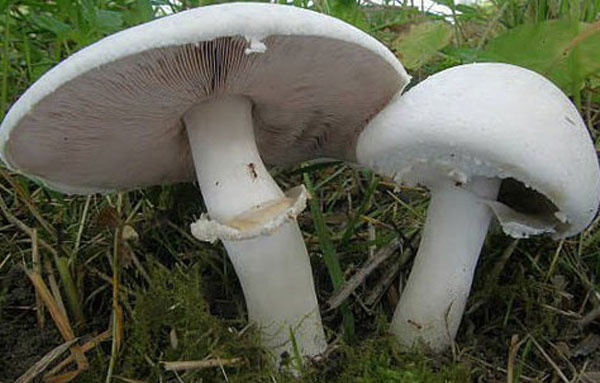
This champignon has counterparts - as a rule, other types of this kind of mushrooms:
- meadow (Agaricus campestris);
- curve (Agaricus abruptibulbus);
- coppice (Agaricus silvicola).
Field champignon differs from them in larger size and place of growth. For example, the curve grows in forests, hiding from the sun, and meadow, as the name implies, likes to settle in meadows. Coppice, like the curve, does not like open spaces.
Fortunately, all these mushrooms are edible, but inexperienced lovers of "quiet hunting" can confuse champignon with poisonous and often deadly representatives of the mushroom kingdom:
- stinky fly agaric or white toadstool (Amanita virosa);
- pale toadstool (Amanita phalloides);
- fly agaric (Amanita citrina);
- spring toadstool or spring fly agaric (Amanita verna).
But, looking closely, one can notice significant differences between these mushrooms - all the poisonous ones on the stem, in its lower part, have a saccular thickening - volva, the plates do not change their color, remaining white, and the surface integuments on the fruiting body do not turn yellow when damaged.
Also, due to inexperience, champignon can be confused with false value (Hebeloma crustuliniforme): in the latter, the cap has a pinkish or slightly yellowish tint, darkening towards the central part, the leg is covered with scales, and it smells like horseradish, but not anise, like champignon.
Among the genus of champignons there is a similar poisonous species - yellow-skinned (Agaricus xanthodermus). It is small in size and differs from the field in its characteristic pharmacy smell. Also, the main difference is that its pulp, if damaged, turns yellow very quickly.
Cossack champignon (Agaricus sylvicola)
Synonyms:
Coppice champignon (Latin Agaricus sylvicola) is a mushroom of the mushroom family (Agaricaceae).
Hat:
Color from white to cream, 5-10 cm in diameter, first spherical, then prostrate-convex. Scales are practically absent. The pulp is relatively thin, firm; anise smell, nutty taste. When pressed, the cap readily takes on a yellow-orange color.
Plates:
Frequent, thin, free, when the mushroom ripens, it gradually changes color from light pink to dark brown.
Spore powder:
Dark brown.
Leg:
5-10 cm high, thin, hollow, cylindrical, slightly widening at the base. The ring is strongly pronounced, white, can hang low, almost to the ground.
Spreading:
Coppice champignon grows singly and in groups in deciduous and coniferous forests from June to late September.
Similar species:
It would be a big mistake to mistake the pale toadstool (Amanita phalloides) for the champignon. This, one might say, is a classic of toxicology. Nevertheless, the main differences between champignons and representatives of the genus Amanita should be known to every young mushroom picker. In particular, the plates of the pale toadstool never change color, remain white until the end, while in champignons they gradually darken, from light cream at the beginning to almost black at the end of their life path. So if you find a small lonely champignon with white plates, leave it alone. This is a poisoned pale toadstool.
It is much easier to confuse Agaricus sylvicola with other members of the mushroom family. Agaricus arvensis is usually larger and does not grow in the forest, but grows in the fields, in gardens, in the grass. Poisonous Agaricus xanthodermus has a strong unpleasant odor (which is described differently everywhere - from carbolic acid to ink), and does not grow in the forest, but in the field. You can also confuse this species with the crooked champignon or, otherwise, "distinctly nodule" (Agaricus abruptibulbus), but the latter is somewhat thinner, higher, does not turn yellow so readily, and is less common.
Edibility:
Cossack Champignon - This is a good edible mushroom that rivals the best of champignons.
Video about mushroom champignon coppice
Remarks Still, it remains unclear how to distinguish between numerous similar types of champignons, even if professionals cannot agree on this. On the one hand, the mind prompts you to focus on the habitat. On the other hand, this is fully justified only for mycorrhizal fungi, and champignons, like all saprotrophs, in principle can grow everywhere, if there would be fertilization.
Description of the mushroom curve
The diameter of the crooked champignon cap is 7-10 centimeters.At first, it looks like a blunt bell in shape, but over time it changes to a truncated cone, while the plates are covered with a blanket, and the edges are bent. Even later, the hat becomes open. Its surface is silky cream or white, and older specimens have a shade of ocher. When pressed and in places of damage, the cap turns yellow.

The blades of the beautiful champignon are thin, free, often spaced. Initially, the color of the plates is white, then it becomes red-brown, and in older specimens it turns into black-brown. Spore powder of brown color. The flesh of the mushroom is dense, yellowish or whitish in color, it turns slightly yellow on the cut. The pulp has a characteristic smell of anise.
The stem of the champignon has a curved cylindrical shape, flat, about 8 centimeters high and about 2 centimeters in diameter, it expands towards the base. The structure of the peduncle is fibrous and becomes hollow with age. The color of the leg is similar to the cap. When pressed, the leg also turns yellow. There is a single-layer ring on the leg, it is thin, wide and hanging.
Places of growth of champignons curves
Curved champignons grow in coniferous forests. They bear fruit from mid-summer to October. These mushrooms love to settle in the forest floor. They are found in groups, but sometimes there are also single specimens.

Champignon dark red
 Champignon dark red (Latin Agaricus haemorroidarius)
Champignon dark red (Latin Agaricus haemorroidarius)
Champignon dark red (lat.Agaricushaemorroidarius)
This type of champignon usually grows in deciduous forests. It is rare. Grows in small groups. It can be found under fallen branches and trees. Ripening season - mid-summer, autumn (June to October).
The mushroom is relatively large. The cap reaches 10-12 cm in diameter. At an early age, bell-shaped, with a blunt apex. Over time, it opens up and becomes prostrate. The color of the cap is brown-brown.
In adulthood, the skin cracks and turns into fibrous scales. The pulp has a soft taste, white color. At the break, it quickly turns red. Has a mild sour smell.
The plates are frequent, loose, light pink in young mushrooms and brown-black in old age. A characteristic feature is that when touched, the plates turn red.
The stem of the mushroom is off-white, hollow. Reaches 8-10 cm in height. Thickening is noticeable at the base. Bears on itself a wide, freely hanging ring, brown. Below the ring, the leg is scaly. Just like the cap and the plates, the leg of the dark red champignon quickly turns red when pressed or broken.
The dark red champignon is an edible mushroom. Has a mild taste.
Not cultivated on an industrial scale. It is used in food in almost any form. It can be marinated, stewed, fried, dried.
Taste qualities of champignons curves
Curved champignons - delicious edible mushrooms. In terms of taste, they are in no way inferior to field mushrooms. They are used in the same way as field mushrooms: they are boiled, fried, pickled, and salted.
Similarity of the crooked champignon with other species
In appearance, the champignon curve resembles a pale toadstool. This is a phenomenally poisonous mushroom, the insidiousness of which was well known in ancient Rome. With the help of pale toadstools, emperors were poisoned in order to achieve the desired throne. Everything in this mushroom is dangerous: juice, spores, mycelium. But at the same time, his appearance does not cause fear, he looks like champignons and russula.
The pale toadstool contains poisons such as amanitins, phalloidin and phallain, all of which have in common that they are deadly. They destroy the liver and kidneys, and can kill a person in a few days. The consequences of poisoning are often irreversible. Poisoning with pale toadstools becomes fatal if 1 gram of pulp falls on 1 kilogram of a person's weight.

You can distinguish the crooked champignon from the pale toadstool by its characteristic strong aniseed smell. In addition, it does not have a Volvo at its base.And if you press on it, yellow spots appear.
Also, the crooked champignon is very similar to the field champignon. Distinguishing between the two is more difficult. A characteristic feature is only the place of distribution and the beginning of the time of fruiting. However, there is no need to be able to recognize these types of mushrooms as they are both edible and tasty.
Other mushrooms of this genus
Common champignon is an edible mushroom. The diameter of its cap is 6-12 centimeters. Its form is closed, hemispherical, later becomes prostrate. The color of the cap is white or brown with small scales. The leg is whitish in color, without tuber. The leg has a thin movable ring.
Common champignons grow in summer and autumn. They can be found in glades and gardens. These are widespread mushrooms. Common champignons have excellent taste, they are suitable for all types of culinary processing, therefore they are highly valued.

Champignon graceful or pink-lamellar - edible mushroom. Outwardly, it resembles a miniature common champignon. The diameter of its cap is only 2.5-3.5 centimeters, and the length of the leg does not exceed 3 centimeters. Moreover, the thickness is even less - 4-5 millimeters. His cap is hemispherical, while the spore-bearing layer is covered with a blanket, then the cap opens, and the blanket breaks.
The surface of the cap is matte, yellowish in color. The leg is rounded, thicker at the base. Its color is yellowish. There is a sagging narrow ring on the leg under the cap, but in mature specimens there are no rings. Delicate champignons are rare mushrooms. They grow from mid-July to late September. Fruiting singly or in groups.
Edible types and varieties of champignons
Some species grow exclusively in forests (A.silvaticus and A.silvisola), and soil saprotrophs (A.bisrorus, A.bitorquis and A.subreronatus) grow in open spaces, among grass stands of different heights. Among other things, there are desert species, which include A. bernardii and A. thabularis.
Field champignon
A. arvensis has a rather large fruiting body, with a thick-fleshed, rounded-bell-shaped or convex-outstretched cap, in the center of which there is a small tubercle or slight flattening. The pulp is white or creamy, with almond or anise aroma. An ocher tint and slow yellowing may be present. The surface is silky or smooth, covered with yellowish or brownish scales. The plates are often spaced and characteristically swollen. The area of the pedicle is cylindrical, smooth, with expansion or thickening at the base. Spores are black-brown.
Forest mushroom
The fruiting body of A. silvaticus has an ovate-bell-shaped or flat-spread cap, often with a protruding tubercle, rusty-brownish brown coloration, with a large number of dark scales. The pulp is white in color, reddening at the cut. The plates are white, reddish or dark brown in color, narrowed at the end. The area of the leg is cylindrical, slightly swollen at the base, with a whitish filmy ring.
Common champignon
A.samrestris has a hemispherical cap with curved inward edges, flat-rounded or outstretched in shape. The central part is convex. The surface is white or brownish in color, it can be dry, silky or finely scaly. The pulp is white in color, reddening at the cut. The plates are white, pinkish or dark brown in color, with a purple tint. The region of the peduncle is straight and even, with a widening or swelling at the base, with a wide whitish ring.
Small scale mushroom
A. squamuliferus is distinguished by a thick-fleshed, at first semicircular, later convex-outstretched cap, with the presence of a wide and obtuse tubercle. The surface part is of fine-scaled type, silky. The area of the leg is cylindrical, sometimes with a slight tuberous base, white, silky-fibrous type.The pulp is white in color, turning pink or reddening at the break. Dark brown spore powder. Plates are free type, often located, brownish in color. The spores are ellipsoidal, with a smooth surface, light brownish in color.
Garden champignon
A.bisrorus has a rounded cap, with curved edges and a residual private veil, represented by thin flakes, pure white or with a brownish tinge. The surface of the cap is smooth, with a gloss in the central part or of the radial-fibrous type, sometimes with scales. The pulp is dense and juicy, acquiring a pinkish or red tint at the cut. Plates of young specimens of pink coloration. With age, the plates turn dark brown with a characteristic purple tint. The leg is cylindrical, pinkish, with a well-defined ring.
Champignon dark red
A. haemorrhoidarius is characterized by a convex or conical cap with a blunt apical part. At the ripening stage, the cap opens almost to a fully flat shape. The skin on the surface is brownish-brown, cracking into individual fibrous-type scales.
The pulp is white, with a thick red color on the cut. It has a not too pronounced mushroom or sour aroma, and also has a mild and pleasant taste. The stem is off-white in color, with a hollow interior and a scaly surface below the ring. At the base of the stem, there is a noticeable thickening immersed in the ground. A well-pronounced membranous ring. Free-type plates, often located, light pink in color.
Mushroom chunky
A. spissicaulis is similar to the previous species and has a hemispherical, rapidly expanding to almost flat cap. The skin is whitish in color, with a smooth surface that is prone to cracking and the formation of brownish yellow scales. The edges are folded down. The flesh is whitish in color, noticeably thick in the cap part. A grayish-red hue appears on the cut and there is a noticeable almond aroma. The leg is club-shaped. The plates are loose and relatively sparse, reddish or chocolate-blackish-brown in color.
Description
The conditionally edible mushroom (Agaricus silvicola) or thin champignon, belonging to the mushroom family and the mushroom genus, has the following species differences:
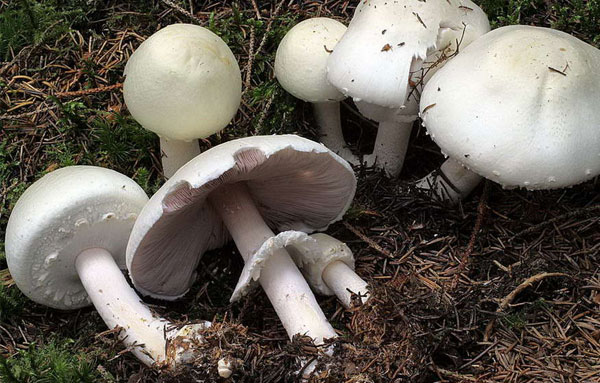
- spherical, ovoid, later convex, outstretched cap. From whitish or yellowish to orange-yellowish or pale ocher in color, with a satin skin, turns yellow where touched. Its diameter varies within 5-10 cm. On the edge, the remains of a veil are sometimes noticeable;
- free plates are often located. At first light pink, as the spores mature, their color changes to brown with lightening edges and chocolate black;
- spores are chocolate brown;
- light silky stem with a fibrous structure, cylindrical, hollow, slightly widened in the lower part. It has a wide hanging ring, at first light, then with a chocolate brown bloom of crumbling spores. The lower surface of the ring is with cesuiks. The maximum diameter of the leg is 1.5 cm, the height is on average 6-9 cm, sometimes it reaches 12 cm;
- thin flesh is dense, white or creamy, gradually turns yellow in places of cut. It has a pronounced anise (almond) aroma and a nutty taste.

